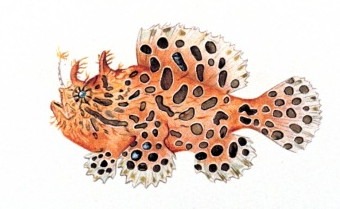Frogfish belong to the anglerfish family Antennariidae. They are mostly found in tropical and subtropical oceans and seas all over the world, except in the Mediterranean Sea. They are small, short, and stocky, and some of them are covered with spinules and other attachments which they use to camouflage.
Frogfish range from 2.5 to 38 cm long. They have a plump, high-backed, and un-streamlined body that is scale-less and bare. Their mouths are upward-pointed and they have palatal teeth. They usually have bright colors such as white, yellow, red, green, and black. Some are also spotted in several colors so they can blend in with the corals that surround them.
Mimicry and Camouflage
Unlike other fish with typical dorsal fins, the three front-most fins of a frogfish are called the illicium or rod and it is mostly topped with the lure. The rod often has striped markings while the lure resembles different species such as another fish, shrimp, and tubeworms. This unusual appearance of frogfishes helps them conceal from predators and as well as to mimic a possible meal to its prey, which is known to be an aggressive mimicry.
Aside from their rods that often resemble other fish and sea creatures, their whole body also sometimes resemble stones, corals, sponges, and even sea squirts with dark splotches instead of holes. Some are also concealed with algae and Hydrozoa. Their concealment is perfect that sometimes sea slugs crawl over them without identifying it.
Most frogfishes can also change colors, however, the change can last from a few days to several weeks, unlike the chameleon which can change its color quickly. However, what triggers their colors to change is unknown.
Frogfish’s Movement
Unlike other fish species who are seen swimming around, frogfishes prefer to lie on the sea floor to wait for prey to approach and they do not move very much. Once they’ve seen a prey they will slowly approach it by using their pectoral and pelvic fins to walk along the floor.
They are rarely seen swimming because they prefer to clamber over the sea bottom with their fins in one of two gaits. One of their movement is by alternately moving their pectoral fins forward, propelling themselves like a two-legged tetrapod.
Another movement they can do is something like a slow gallop. Their pectoral fins are being moved at the same time in a forward and backward motion, transporting their weight to the pelvic fins while moving the pectorals frontward.
When frogfishes are in open water, they are able to swim with strokes of the tail fin. Younger frogfishes, on the other hand, uses a kind of jet propulsion to swim. It is done by rhythmically forcing their breath-water out through their gill openings that are found behind their pelvic fins.
How They Hunt
Frogfishes hunt for crustaceans and other fish even the same kind as them. Once it spots its potential prey, it follows it with its eyes. Then, it will begin to move its rod in a way that the lure imitates the motions of the animal it looks like. As the prey gets near, the frogfish then moves slowly to approach it while adjusting its mouth’s angle.
A frogfish can extend its mouth up to 12 folds, which can pull the prey into its mouth along with water. It can attack its prey for as fast as 6 milliseconds. Once the prey has been swallowed, its esophagus will be closed by a special muscle to prevent the victim from escaping. Their mouths are not the only body part that can expand because their stomachs can also inflate for them to swallow bigger animals.
How They Reproduce
Most species of frogfish reproduce by free-spawning. Female frogfish lay eggs in the water and males come in behind to fertilize them. The abdomen of a female frogfish starts to swell with up to 180,000 eggs, from eight hours to several days before the egg-laying. Then two days before the spawning, a male frogfish begins to approach the female frogfish.
During the pre-spawning ritual, the male frogfish swims beside the female frogfish, nudges her with his mouth, then remains near her cloaca. The female will begin to swim above the ocean floor toward the surface just before the spawning. Then, at the highest point of their swim, they will release the eggs and sperm before descending.
There are also times when the male frogfish pulls the egg out of the female with his mouth. After mating, they would depart quickly as otherwise, the smaller male would likely be eaten.
Other species of frogfish, on the other hand, are substrate-spawners which lay eggs on solid surfaces such as on plants and rocks. There are also some who guard their eggs, which is a duty assigned to the male frogfish, while some do not. There are also other species of frogfish that practice brood carrying such as the three-spot frogfish. Its eggs are attached to the male and the brood are carried in the pectoral fins.
The eggs of a frogfish are usually 0.5 to 1mm in diameter. After two to five days, these will hatch and they will live on the yolk sac while their digestive systems are still being developed. A young frogfish looks similar to a tiny tentacled jellyfish. It will live like planktons for two months, often mimicking the colors of poisonous sea slugs or flatworms. After that stage, it will fully become an adult frogfish and begin its life on the seafloor.
The frogfish is indeed a unique and fascinating creature. It is able to survive on the sea floor with its bizarre characteristics that help it hide from predators and hunt for foods as well. No wonder it has been tagged as the ocean’s master of aggressive mimicry.


